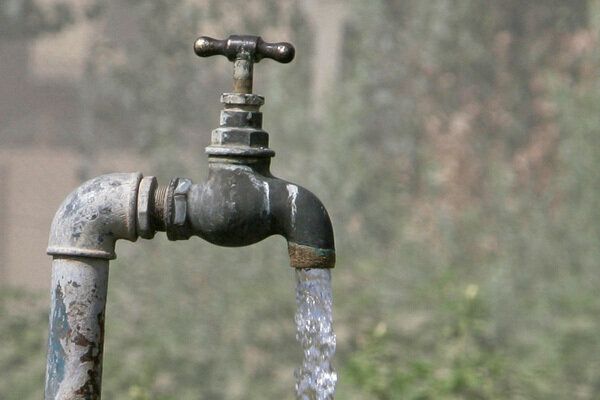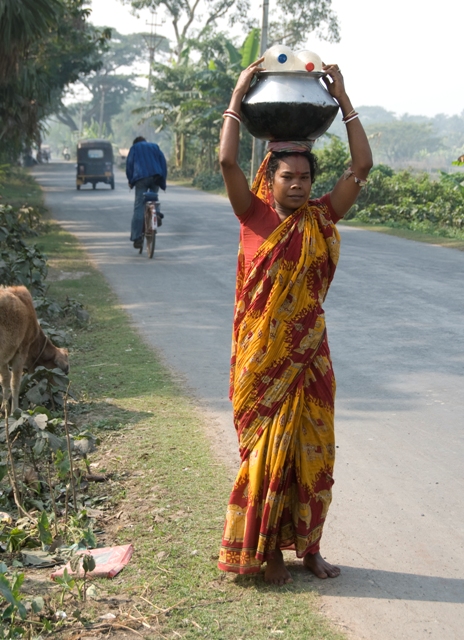
There is a photograph that travelers inevitably take when they go to a developing country -- a picture of a woman carrying a large container of water on her head. The woman's posture is ramrod straight, the envy of runway models everywhere, and her face rarely betrays the amount of effort and strength this task involves. Most times this photo is taken because it is a stunning and moving image of a woman's strength and beauty.
Alluring as this image may be, what it truly portrays is the economic, physical and health burden that women and girls must endure everyday of their lives to provide water for their families - this is the forgotten glass ceiling.
 Credit: John Kayser, courtesy of Water For People
Credit: John Kayser, courtesy of Water For People
Whether a woman lives in Africa, South America or Asia, one of her primary tasks is to gather water for her family. There is no convenience of indoor plumbing for these women. Compare the trek you make to your bathroom or kitchen for a glass of water to the journey women in the developing world must make -- 3 miles a day on average -- to fetch dirty water from mainly contaminated sources, such as rivers, unprotected springs and shallow wells. All this fetching for water uses up 40 billion hours annually of women's time worldwide. It could be more productively spent on income-generating activities, education and caring for their families.
The quality of the water women gather greatly impacts their and their families' health. Water from unsafe sources is contaminated with pathogens that cause debilitating and deadly water-borne diseases (such as cholera, typhoid and amoebic dysentery). Diarrheal diseases such as these kill more children under 5 than AIDS, Malaria and TB combined. Only with safe and accessible water will women and their families have a chance to live and to lead productive lives.
The incongruity of this situation is that we know how to relieve women of this burden. Industrialized countries eradicated most water-borne diseases 100 years ago by distributing chlorinated treated water through piped distribution systems and treating sewage before it reaches our public water sources. That is why you don't think about contracting typhoid when you brush your teeth in the morning.
While these large infrastructure-based systems may not be the answer for all of the developing world, there are many small-scale doable solutions that provide safe and sustainable water and sanitation. Even providing simple pit latrines, household water treatment and educating people on proper hand-washing can help stop the contamination of water sources and reduce the cases of diarrheal diseases significantly.
For example, in Bangladesh, WaterPartners International worked with Ms. Rasheda Khatun, age 28, to provide her community a new pit latrine with bamboo lining. This intervention has stopped the use of hanging latrines (a basic latrine constructed over a river or stream) and defecating out in the open. Hygienic latrines help prevent the spread of disease.
Throughout the developing world girls often drop out of school when they reach puberty because they don't have a separate place to go to the toilet. UNICEF's efforts in Malawi allowed Eveless to go back to school again when they installed a water borehole and separate toilets for girls and boys. Two years before she had dropped out of school and feared she would never realize her dream to become a nurse. In Guatemala, Water For People and the Global Water Challenge are helping to provide Magdalena's school with safe drinking water, sanitation and hygiene education. In Cambodia RDIC works with teachers who act as sales people and marketers to sell ceramic water filters, which have reduced diarrheal disease amongst users by 46%.
Other non-governmental organizations such as Action Against Hunger, Africare and CARE work all over the developing world to help women get the safe drinking water they and their families deserve.
So let's start thinking of that iconic image of a woman carrying water on her head as the BEFORE picture and let's try to achieve the AFTER picture -- healthy women with access to safe drinking water for them and their families and girls in school.
If people across the United States joined together to support water and sanitation projects they could immediately help woman shatter the most basic of glass ceilings -- access to safe drinking water and sanitation.
Andra Tamburro from Water Advocates co-authored this blog